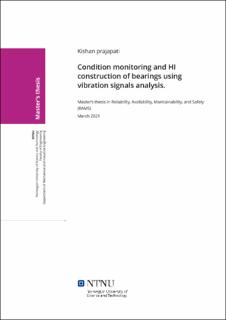| dc.description.abstract | A bearing is one of the important components in rotatory machines and has been widely used in various industries. It plays a critical role in the rotating machines. The functionality and performance of the bearings directly affect the operational performance, reliability, and safety of these rotating machines and related systems. Therefore, it is very important to maintain the good condition of the bearings of the rotating machinery. Condition-based maintenance is one of the best ways to maintain the good condition of the machinery which includes the condition monitoring of the machinery and carrying out the maintenance work before it goes to failure. Vibration analysis is the most popular technique for condition monitoring of the bearing. Vibration data collected from the bearing should be analyzed to detect the faults and track the degradation level.
The vibration signal of rolling bearings has a strong non-stationary property which makes it difficult to fault diagnosis. It requires advanced time-frequency signal processing techniques to extract all the relevant information from the vibration signal. All types of signal processing types are studied thoroughly and compared with each other. Finally, Hilbert–Huang transform (HHT) is chosen for analysis of the vibration signals. It has good computation efficiency and does not involve the concept of frequency resolution and time resolution. Empirical mode decomposition (EMD) is the first step of HHT. But, EMD has got a mode mixing problem, which is eliminated by Ensemble empirical mode decomposition (EEMD). So, it is selected as a signal processing technique for this study.
The accelerated run-to-failure vibration data of roller bearings are collected from the RAMS laboratory at NTNU by running the experiments. and each sample is decomposed into a finite number of intrinsic mode functions (IMFs) using the EEMD method. The sensitive IMFs are selected using the correlation coefficient criterion. Five statistical time-domain features and instantaneous energy is extracted from the sensitive IMFs which indicates the condition of the bearings. These features are compared by looking at their three properties: monotonicity, prognosability, and trendability, and the best one is selected as a health indicator of the bearing which can give the current condition as well as tracks the degradation level and the degradation path. The health indicator can be used for the RUL estimation of the bearing and maintenance optimization. | |
